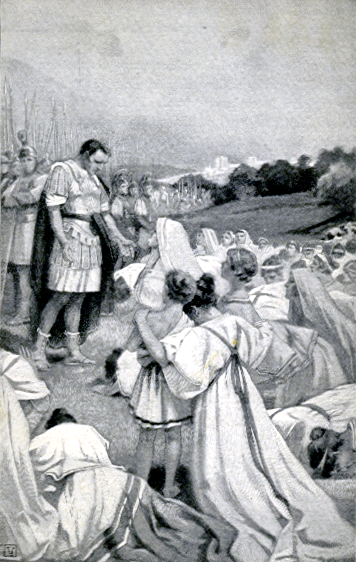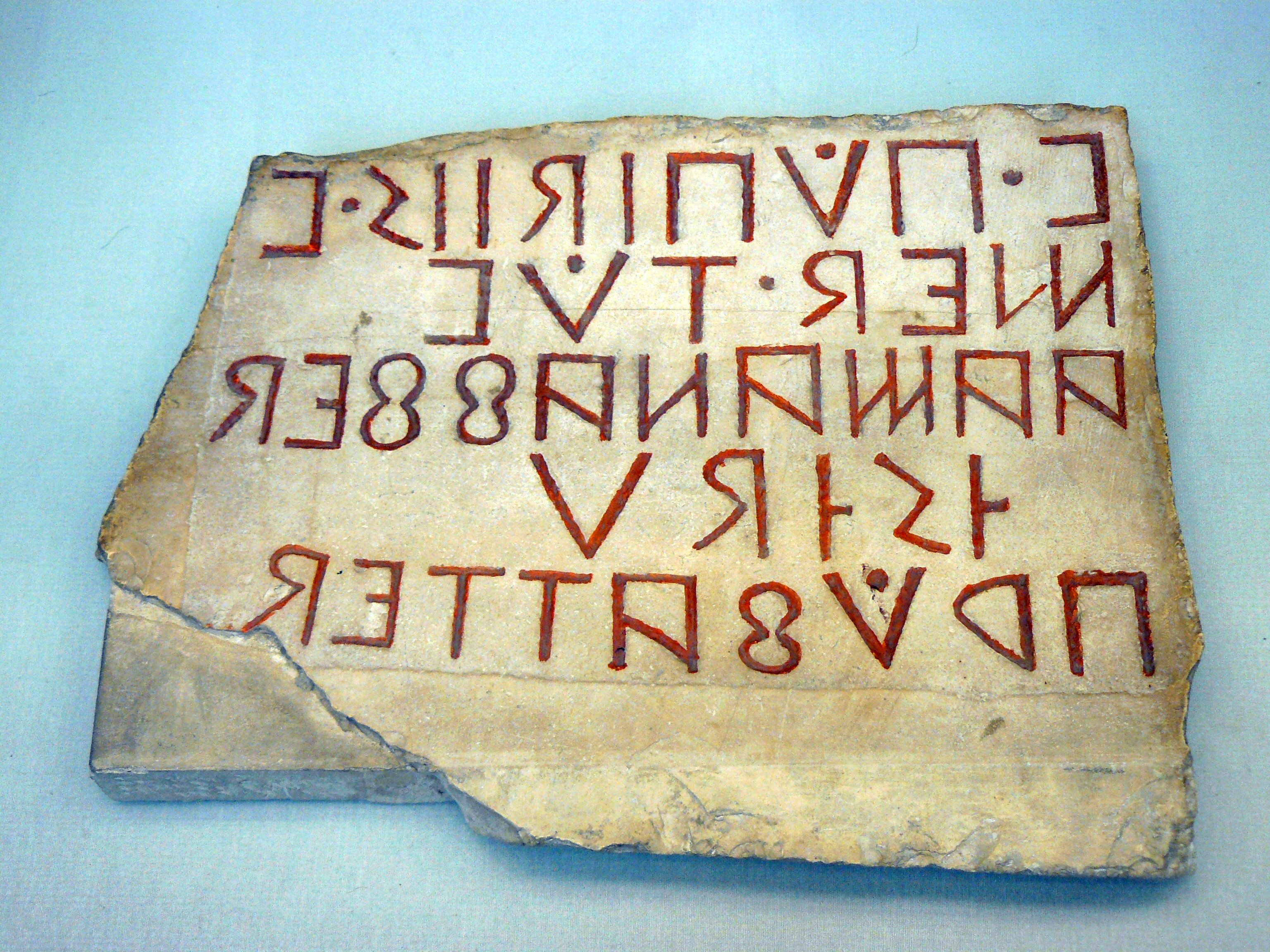|
Volscians
The Volsci (, , ) were an Italic tribe, well known in the history of the first century of the Roman Republic. At the time they inhabited the partly hilly, partly marshy district of the south of Latium, bounded by the Aurunci and Samnites on the south, the Hernici on the east, and stretching roughly from Norba and Cora in the north to Antium in the south. Rivals of Rome for several hundred years, their territories were taken over by and assimilated into the growing republic by 300 BCE. Rome's first emperor Augustus was of Volscian descent. Description by the ancient geographers Strabo says that the Volsci formed a sovereign state near the site of Rome. It was placed in the Pomentine plain, between the Latins and the Pontine marshes, which took their name from the plain. Language The Volsci spoke Volscian, a Sabellic Italic language, which was closely related to Oscan and Umbrian, and more distantly to Latin. In the Volscian territory lay the little town of Velitrae (modern Vel ... [...More Info...] [...Related Items...] OR: [Wikipedia] [Google] [Baidu] |
Gaius Marcius Coriolanus
Gnaeus (or Gaius) Marcius Coriolanus was a Roman general who is said to have lived in the 5th century BC. He received his toponymic cognomen "Coriolanus" following his courageous actions during a Roman siege of the Volscian city of Corioli. He was subsequently exiled from Rome, and led troops of Rome's enemy the Volsci to besiege the city. In later ancient times, it was generally accepted by historians that Coriolanus was a real historical individual, and a consensus narrative story of his life appeared, retold by leading historians such as Livy, Plutarch, and Dionysius of Halicarnassus. More recent scholarship has cast doubt on the historicity of Coriolanus, with some portraying him as either a wholly legendary figure or at least disputing the accuracy of the conventional story of his life or the timing of the events. According to Plutarch, his ancestors included prominent patricians such as Censorinus and even an early King of Rome. The story is the basis for the tragedy of '' ... [...More Info...] [...Related Items...] OR: [Wikipedia] [Google] [Baidu] |
Aurunci
The Aurunci were an Italic tribe that lived in southern Italy from around the 1st millennium BC. They were eventually defeated by Rome and subsumed into the Roman Republic during the second half of the 4th century BC. Identity Aurunci is the name given by Roman writers to an ancient race or nation of Italy. It appears that "Aurunci" was the appellation the Romans gave to the people called " Ausones" by the Greeks. One form might be derived from the other by rhotacism (corruption of sound "s" in "r") (Ausoni > Auroni > Auronici > Aurunci). The identity of the two is distinctly asserted by Servius, and clearly implied by Cassius Dio, where he says that the name of Ausonia was properly applied only to the land of the Auruncans, between the Volscians and the Campanians. In like manner, Festus makes the mythical hero Auson the founder of the city of Aurunea. Servius terms the Aurunci one of the most ancient nations of Italy. They appear to have been much more powerful and widely spre ... [...More Info...] [...Related Items...] OR: [Wikipedia] [Google] [Baidu] |
Volscian Language
Volscian was a Sabellic Italic language, which was spoken by the Volsci and closely related to Oscan and Umbrian. Overview Volscian is attested in an inscription found in Velitrae (Velletri), dating probably from early in the 3rd century BC; it is cut upon a small bronze plate (now in the Naples Museum), which must have once been fixed to some votive object, dedicated to the god ''Declunus'' (or the goddess ''Decluna'').Baldi, Phillip. ''The Foundations of Latin''. New York: Mouton de Gruyter. 2002. pp. 140-142. The language of this inscription is clear enough to show the very marked peculiarities that rank it close to the language of the Iguvine Tables. It shows on the one hand the labialization of the original velar ''q'' (Volscian ''pis'' = Latin ''quis''), and on the other hand it palatalizes the guttural ''c'' before a following ''i'' (Volscian ''facia'' Latin ''faciat''). Like Umbrian also, but unlike Latin and Oscan, it has changed all the diphthongs into simple vowels (V ... [...More Info...] [...Related Items...] OR: [Wikipedia] [Google] [Baidu] |
Samnites
The Samnites () were an ancient Italic people who lived in Samnium, which is located in modern inland Abruzzo, Molise, and Campania in south-central Italy. An Oscan-speaking people, who may have originated as an offshoot of the Sabines, they formed a confederation consisting of four tribes: the Hirpini, Caudini, Caraceni, and Pentri. Although allied together against the Gauls in 354 BC, they later became enemies of the Romans and fought them in a series of three wars. Despite an overwhelming victory at the Battle of the Caudine Forks (321 BC), the Samnites were subjugated in 290 BC. Although severely weakened, the Samnites would still side against the Romans, first in the Pyrrhic War and then with Hannibal in the Second Punic War. They also fought in the Social War and later in Sulla's civil war as allies of the Roman consuls Papirius Carbo and Gaius Marius against Sulla, who defeated them and their leader Pontius Telesinus at the Battle of the Colline Gate (82 BC). Afterward ... [...More Info...] [...Related Items...] OR: [Wikipedia] [Google] [Baidu] |
Sabellic
The Osco-Umbrian, Sabellic or Sabellian languages are an extinct group of Italic languages, the Indo-European languages that were spoken in Central and Southern Italy by the Osco-Umbrians before being replaced by Latin, as the power of Ancient Rome expanded. Their written attestations developed from the middle of the 1st millennium BC to the early centuries of the 1st millennium AD. The languages are known almost exclusively from inscriptions, principally of Oscan and Umbrian, but there are also some Osco-Umbrian loanwords in Latin. Besides the two major branches of Oscan and Umbrian (and their dialects), South Picene may represent a third branch of Sabellic. The whole linguistic Sabellic area, however, might be considered a dialect continuum. Paucity of evidence from most of the "minor dialects" contributes to the difficulty of making these determinations. Relationship with the Italic languages Following an original theory by Antoine Meillet, the Osco-Umbrian languages were tra ... [...More Info...] [...Related Items...] OR: [Wikipedia] [Google] [Baidu] |
Oscan Language
Oscan is an extinct Indo-European language of southern Italy. The language is in the Osco-Umbrian or Sabellic branch of the Italic languages. Oscan is therefore a close relative of Umbrian. Oscan was spoken by a number of tribes, including the Samnites, the Aurunci ( Ausones), and the Sidicini. The latter two tribes were often grouped under the name "Osci". The Oscan group is part of the Osco-Umbrian or Sabellic family, and includes the Oscan language and three variants ( Hernican, Marrucinian and Paelignian) known only from inscriptions left by the Hernici, Marrucini and Paeligni, minor tribes of eastern central Italy. Adapted from the Etruscan alphabet, the Central Oscan alphabet was used to write Oscan in Campania and surrounding territories from the 5th century BCE until possibly the 1st century CE. Evidence Oscan is known from inscriptions dating as far back as the 5th century BCE. The most important Oscan inscriptions are the Tabula Banti ... [...More Info...] [...Related Items...] OR: [Wikipedia] [Google] [Baidu] |
Umbrian Language
Umbrian is an extinct Italic language formerly spoken by the Umbri in the ancient Italian region of Umbria. Within the Italic languages it is closely related to the Oscan group and is therefore associated with it in the group of Osco-Umbrian languages, a term generally replaced by Sabellic in modern scholarship. Since that classification was first formulated, a number of other languages in ancient Italy were discovered to be more closely related to Umbrian. Therefore, a group, the Umbrian languages, was devised to contain them. Corpus Umbrian is known from about 30 inscriptions dated from the 7th through 1st centuries BC. The largest cache by far is the Iguvine Tablets, sevenThe tradition born in the 17th century that the tablets were originally nine, and that two, sent to Venice, never came back, must be considered spurious. Paolucci (1966), p. 44 inscribed bronze tablets found in 1444 near the village of Scheggia or, according to another tradition, in an underground chamber a ... [...More Info...] [...Related Items...] OR: [Wikipedia] [Google] [Baidu] |
Latin
Latin (, or , ) is a classical language belonging to the Italic branch of the Indo-European languages. Latin was originally a dialect spoken in the lower Tiber area (then known as Latium) around present-day Rome, but through the power of the Roman Republic it became the dominant language in the Italian region and subsequently throughout the Roman Empire. Even after the fall of Western Rome, Latin remained the common language of international communication, science, scholarship and academia in Europe until well into the 18th century, when other regional vernaculars (including its own descendants, the Romance languages) supplanted it in common academic and political usage, and it eventually became a dead language in the modern linguistic definition. Latin is a highly inflected language, with three distinct genders (masculine, feminine, and neuter), six or seven noun cases (nominative, accusative, genitive, dative, ablative, and vocative), five declensions, four verb conjuga ... [...More Info...] [...Related Items...] OR: [Wikipedia] [Google] [Baidu] |
Velletri
Velletri (; la, Velitrae; xvo, Velester) is an Italian ''comune'' in the Metropolitan City of Rome, approximately 40 km to the southeast of the city centre, located in the Alban Hills, in the region of Lazio, central Italy. Neighbouring communes are Rocca di Papa, Lariano, Cisterna di Latina, Artena, Aprilia, Nemi, Genzano di Roma, and Lanuvio. Its motto is: ('Liberty of pope and empire is given to me'). Velletri was an ancient city of the Volsci tribe. Legendarily it came into conflict with the Romans during the reign of Ancus Marcius, the fourth king of Rome; then again in the fifth and fourth centuries BCE, during the early Roman Republic. Velletri was also the home of the Octavii, the paternal family of the first Roman Emperor Augustus. In the Middle Ages, it was one of the few " free cities" in Lazio and central Italy. It was the site of two historic battles in 1744 and 1849. During the Second World War, it was at the centre of fierce fighting between the Germans and ... [...More Info...] [...Related Items...] OR: [Wikipedia] [Google] [Baidu] |
Aequi
300px, Location of the Aequi (Equi) in central Italy, 5th century BC. The Aequi ( grc, Αἴκουοι and Αἴκοι) were an Italic tribe on a stretch of the Apennine Mountains to the east of Latium in central Italy who appear in the early history of ancient Rome. After a long struggle for independence from Rome, they were defeated and substantial Roman colonies were placed on their soil. Only two inscriptions believed to be in the Aequian language remain. No more can be deduced than that the language was Italic. Otherwise, the inscriptions from the region are those of the Latin-speaking colonists in Latin. The colonial exonym documented in these inscriptions is Aequi and also Aequicoli ("colonists of Aequium"). The manuscript variants of the classical authors present Equic-, Aequic-, Aequac-. If the form without the -coli is taken as an original, it may well also be the endonym, but to date further evidence is lacking. Historical geography The historians made many entries co ... [...More Info...] [...Related Items...] OR: [Wikipedia] [Google] [Baidu] |





